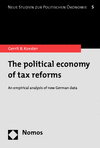Zusammenfassung
Was bestimmt die Steuerpolitik? Welche Ziele verfolgen die Bundesregierungen bei Steuerreformen? Haben Steuererhöhungen und Steuersenkungen einen Einfluss auf die Wahlergebnisse? Auf der Basis eines neuen Datensatzes zu den fiskalischen Effekten von Steuerreformen im Zeitraum von 1964 bis 2004 zeigt das Werk Muster der Steuerpolitik auf und testet zentrale ökonomische Hypothesen. Dabei zeigt sich, dass normative ökonomische Ansätze kaum einen Erklärungsbeitrag für die zu beobachtende Steuerpolitik leisten können.
Ausgehend von wichtigen polit-ökonomischen Theorien zeigt der Autor, dass die Mehrheitskonstellationen im Bundesrat einen wichtigen Einfluss auf die Steuerpolitik haben, allerdings genau umgekehrt wie von der Blockade-Hypothese behauptet: Steuerreformen sind gemessen an ihren Fiskaleffekten bei gegenläufigen Mehrheiten in Bundestag und Bundesrat häufiger und umfangreicher. Des Weiteren gibt es keine Hinweise darauf, dass die parteipolitische Zusammensetzung der Bundesregierung einen wichtigen Einfluss auf Steuerreformen hat. Wahltaktische Terminierungen von Steuerreformen spielen aber sehr wohl eine wichtige Rolle. Eine Auswertung des Zusammenhangs von Steuerreformen und Wahlergebnissen zeigt allerdings, dass die Versuche der Bundesregierungen, ihre Wiederwahlwahrscheinlichkeit durch Steuersenkungen kurz vor der Wahl zu erhöhen, wenig erfolgreich sind: Nicht nur die Jahre unmittelbar vor den Wahlterminen, sondern die Steuerpolitik in der gesamten Legislaturperiode hat einen Einfluss auf die Bundestagswahlergebnisse der regierenden Parteien.
Abstract
Was bestimmt die Steuerpolitik? Welche Ziele verfolgen die Bundesregierungen bei Steuerreformen? Haben Steuererhöhungen und Steuersenkungen einen Einfluss auf die Wahlergebnisse? Auf der Basis eines neuen Datensatzes zu den fiskalischen Effekten von Steuerreformen im Zeitraum von 1964 bis 2004 zeigt das Werk Muster der Steuerpolitik auf und testet zentrale ökonomische Hypothesen. Dabei zeigt sich, dass normative ökonomische Ansätze kaum einen Erklärungsbeitrag für die zu beobachtende Steuerpolitik leisten können.
Ausgehend von wichtigen polit-ökonomischen Theorien zeigt der Autor, dass die Mehrheitskonstellationen im Bundesrat einen wichtigen Einfluss auf die Steuerpolitik haben, allerdings genau umgekehrt wie von der Blockade-Hypothese behauptet: Steuerreformen sind gemessen an ihren Fiskaleffekten bei gegenläufigen Mehrheiten in Bundestag und Bundesrat häufiger und umfangreicher. Des Weiteren gibt es keine Hinweise darauf, dass die parteipolitische Zusammensetzung der Bundesregierung einen wichtigen Einfluss auf Steuerreformen hat. Wahltaktische Terminierungen von Steuerreformen spielen aber sehr wohl eine wichtige Rolle. Eine Auswertung des Zusammenhangs von Steuerreformen und Wahlergebnissen zeigt allerdings, dass die Versuche der Bundesregierungen, ihre Wiederwahlwahrscheinlichkeit durch Steuersenkungen kurz vor der Wahl zu erhöhen, wenig erfolgreich sind: Nicht nur die Jahre unmittelbar vor den Wahlterminen, sondern die Steuerpolitik in der gesamten Legislaturperiode hat einen Einfluss auf die Bundestagswahlergebnisse der regierenden Parteien.
- 17–18 I Introduction 17–18
- 35–35 5 Summary 35–35
- 47–47 4 Summary 47–47
- 79–84 2.5 Property taxes 79–84
- 84–85 2.6 Summary 84–85
- 109–109 2.3 Tax smoothing 109–109
- 109–110 2.4 Summary of findings 109–110
- 153–154 3.9 Summary 153–154
- 165–165 4.3 Summary 165–165
- 169–185 VII Bibliography 169–185

